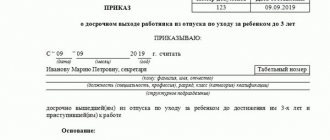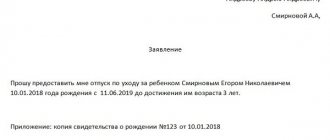Home / Labor Law / Leave / Maternity leave
Back
Published: 06/03/2016
Reading time: 6 min
0
1036
The term “maternity leave” does not exist in labor legislation. This concept includes periods of employee absence from work due to maternity leave and child care.
The first type of leave is provided exclusively to women. Usually it is just over 4 months, divided into equal periods before and after childbirth.
Parental leave can be granted to both the mother and another family member.
- Duration
- Reducing the period
- Extension of vacation
Maternity leave: what is it, what periods are considered maternity leave
Maternity leave (M&L) is received by a working or student citizen if she is pregnant and has reached the statutory number of weeks of pregnancy. A woman will receive leave for the period prescribed by law before and after the birth of a child or several children. After the BiR leave, the state gives the right to receive leave to care for a newborn child until he turns three years old.
Maternity leave
With this leave, the state gives the woman the opportunity to prepare for childbirth, and then relax herself and spend time with the baby in the very first days of his life. The right to leave the BiR is given by the provisions of Art. 255 of the Labor Code of the Russian Federation, which states that during the vacation period a woman is entitled to benefits from the Social Insurance Fund.
Let us note that the law dated June 29, 2015 No. 201-FZ establishes the right to labor and employment leave not only for women who work permanently, but also for those who were registered for work temporarily. If before the law was issued, the state obliged to extend the temporary employment contract with a pregnant employee until childbirth, but now a woman who worked under a temporary contract is also entitled to paid postpartum leave.
Leave is granted not only at birth, but also at adoption, if by the time the adoption is formalized the baby is under three months old.
A young mother should find out which periods qualify as B&R leave in order to go on maternity leave on time
Parental leave until the child reaches three years of age
Leave to care for a child until he or she reaches three years of age is regulated by Art. 256 Labor Code of the Russian Federation. After the B&R leave, the baby's mother can apply for such leave. However, it is not always the mother of the newborn who receives care leave.
If the mother of a newborn has a high salary and works in a significant position, it is more in the interests of the family for the child’s father, working grandmother, or some other close relative to go on such leave. For example, this could be the child’s adult older sister.
Art. 256 of the Labor Code leaves this choice to the discretion of the family. Moreover, during this leave, different relatives can take turns caring for the baby, if the family makes such a choice.
How pension points are accumulated during maternity leave
Since 2015, the state has awarded pension coefficients (points) to workers under an employment contract for each year of work. Law No. 400-FZ of December 28, 2013 states that the number of such points is proportional to the amount of insurance contributions to the Pension Fund made by the employer for a specific employee.
The legislation provides that, in addition to periods of actual work, socially significant periods are also taken into account when calculating a worker’s pension points. These also include parental leave for children up to one and a half years old. Pension points are awarded as follows:
- 1.8 points for one year of care - for the first child;
- 3.6 points for one year of care - for a second child;
- 5.4 points for one year of care - for the third or fourth child.
Pension points in this amount are counted for a full calendar year. For example, if a child was cared for up to one year, i.e. only 9 months, then the number of pension points will be 1.8 / 12 months * 9 months = 1.35.
After the baby turns one and a half years old, pension points are not awarded.
The Pension Fund of the Russian Federation awards pension points to women on maternity leave for up to one and a half years.
Maternity leave - comprehensive leave
The persistent jargon of “maternity leave” actually hides 2 different vacations, the only common feature of which is their connection with the birth of a child.
- Maternity leave
- Leave related to the need to care for a child up to 1.5 or three years of age.
Components of the maternity leave:
- have different bases;
- are issued separately and each in its own way;
- of various durations;
- payment differs between the employer and the state.
Rumor has united them into a common “maternity leave”, since in practice in most cases they go one after the other and have no breaks between them.
REFERENCE! Legislatively, the right to leave related to future motherhood is regulated by Art. 255-256 of the Labor Code of the Russian Federation. Special and work experience is not interrupted by a long maternity leave.
What benefits are provided to pregnant women before maternity leave?
Every pregnant citizen of the Russian Federation has the right to state benefits, which she receives if the following conditions are met:
- She remains at any stage of gestation.
- She consulted a gynecologist, who confirmed the presence of pregnancy.
- She registered (registered) at the clinic at her place of permanent registration.
Each pregnant woman, regardless of the fact of employment, is entitled to a one-time benefit if she is registered with a medical organization in the first trimester of pregnancy, i.e. up to 12 weeks (Article 3 and Article 9 of 81-FZ of May 19, 1995).
This benefit is paid from the regional Social Insurance Fund. The benefit amount from 02/01/2018 is 628.47 rubles.
Another preferential payment to pregnant women is a one-time allowance for the wives of military personnel serving on conscription (Article 14.2 81-FZ of May 19, 1995). The amount of such a one-time benefit from 02/01/2018 is 26,539 rubles 76 kopecks.
An option for benefits for pregnant women can be considered the preferential options for working hours provided for by the Labor Code of the Russian Federation, which reduce workload, fatigue, and eliminate harm to the health of the pregnant child.
A certificate about the need to transfer a pregnant employee to light work is given by a gynecologist. The pregnant woman submits an application for transfer to the employer accompanied by such a certificate. Light work implies the absence of contact with harmful substances, an individual work schedule (Article 49 of the Labor Code of the Russian Federation), which implies the ability to shift the hours of the working day.
The right to an individual schedule even gives the expectant mother the opportunity to reduce the length of her working day or week. Of course, with such a change in the schedule, the pregnant woman is paid for the time actually worked. It is important that this will not lead to a reduction in the duration of annual leave.
The following are completely contraindicated for pregnant women:
- lifting weights;
- contact with chemicals and x-rays;
- work on night shifts.
So, a pregnant employee can write an application for transfer to work only on the day shift (Labor Code of the Russian Federation, Article 96), transfer from hazardous or physically demanding production to easier work. In such cases, the preservation of average earnings is provided (Labor Code of the Russian Federation, Article 254). No one has the right to prevent a pregnant woman from visiting doctors (Article 254 of the Labor Code of the Russian Federation). In this case, the time spent visiting a doctor must also be paid according to average earnings, if the employee has provided a certificate.
Important: dismissal of pregnant women is illegal (Article 261 of the Labor Code of the Russian Federation). Refusal to hire pregnant women is also prohibited by law.
If you are pregnant and they are trying to fire you, do not despair, but stand up for your rights
How to take sick leave during pregnancy
If a pregnant woman experiences symptoms that are not related to her situation, such as a runny nose, she should see a GP. He, of course, should be notified of your pregnancy if the due date is not yet very noticeable outwardly.
Any doctor, for example, a therapist, an ophthalmologist, a neurologist, can give a sick leave to a pregnant woman according to his indications, depending on the complaints that the woman came with.
Pregnant women turn to a gynecologist due to symptoms characteristic specifically of pregnancy:
- dizziness;
- fatigue;
- drowsiness or insomnia;
- leg cramps;
- swelling;
- nausea and vomiting;
- nagging pain in the abdomen;
- vaginal discharge.
The gynecologist will determine how strongly these symptoms affect the woman’s health and the risk of miscarriage. Previously, a gynecologist had the right to issue a certificate of incapacity for work for a long period with such a diagnosis as “toxicosis of pregnancy” and “threat of miscarriage”. Now the rules have changed. With such diagnoses, the gynecologist refers to the hospital, where they issue a certificate of incapacity for work, which, if necessary, can last for the entire period of gestation.
A certificate of incapacity for work for pregnancy and childbirth is issued on a standard form
How to obtain a certificate of incapacity for work?
What documents are needed for sick leave for pregnancy and childbirth?
Sick leave is issued at the 30th week of pregnancy if one child is expected, and at the 28th week if two or more .
The following documents are required for this:
- passport;
- compulsory health insurance policy (CHI);
- insurance certificate of compulsory pension insurance (SNILS).
How is sick leave issued for pregnancy and childbirth? An obstetrician-gynecologist has the right to issue sick leave , and in his absence, a general practitioner or paramedic. If a woman is registered at the antenatal clinic at her place of registration, a certificate of incapacity for work is issued there.
Sometimes pregnant women prefer to be observed in private medical centers. In this case, registration depends on whether the clinic has the right to issue certificates of incapacity for work (this right is confirmed by the appropriate certificate). If there is one, sick leave is issued in the same way as in consultation.
If not, you need to contact the antenatal clinic to obtain a certificate of incapacity for work . In addition to the documents listed above, you will need to provide:
- statement;
- a certificate from the doctor who cared for the pregnancy;
- exchange card, which was kept in the clinic during pregnancy.
If a child was born prematurely and before 30 weeks of pregnancy, a certificate of incapacity for work is issued in the maternity hospital. Leave in this case lasts 156 days if the child was born alive and 86 if dead.
Attention! An employee can bring a certificate of incapacity for work even after the end of maternity leave. 6 months are allotted for this from the date of its completion.
The sick leave certificate is issued on a special A4 format.
The document is certified by the signature of a doctor (usually an obstetrician-gynecologist) and the seal of the medical institution that issued it .
Corrections on the sheet are not allowed.
In some cases, there is a need to extend disability:
- In case of complications of childbirth – for 16 days.
- If only during childbirth it was discovered that the pregnancy was multiple - for 54 days .
In this case, an additional certificate of incapacity for work is issued. It must indicate the number of the previous (main) one and the reason for the extension.
How long does maternity leave last by law?
An important question for expectant mothers is when they can go on vacation. And also an important issue is the duration of the vacation.
Table: start and duration of holiday according to BiR
| Conditions for calculation | Gestation period when going on maternity leave, weeks | Duration of vacation, days | ||
| Total | Before giving birth | After childbirth | ||
| Normal pregnancy with one child | 30 | 140 | 70 | 70 |
| Premature birth (between 22 and 30 weeks) | — | — | 156 | 156 |
| Difficult childbirth during normal pregnancy | 30 | 156 | 70 | 86 |
| When more than one child is born | 28 | 194 | 84 | 110 |
| If a multiple pregnancy is detected during childbirth | 30 | 194 | 70 | 124 |
| For women living in the zone of eviction due to the Chernobyl disaster | 27 | 160 | 90 | 70 |
| For women living in the area of eviction due to the Chernobyl disaster with complicated childbirth | 27 | 176 | 90 | 86 |
| For women living in the zone of eviction due to the Chernobyl disaster upon the birth of twins | 27 | 200 | 90 | 110 |
Please note that there is no clear answer for all pregnant women. The duration of leave and the duration of leave depends on many reasons, such as the birth of twins.
Expectant mothers need to know the timing of maternity leave and the number of days on leave according to BiR
Vacation under the BiR is calculated in total, and the woman always receives the total number of days of vacation, regardless of how many days she used before giving birth. When adopting a newborn under Art. 257 of the Labor Code of the Russian Federation provides for leave lasting from the date of registration of adoption and up to 70 days from the date of birth of the adopted child, and if there is more than one child - up to 110 days.
If both spouses formalize the adoption, such leave is entitled to one of them at their discretion. If the adoptive parents wish to ensure the preservation of the secrecy of adoption as provided for by law, the adoptive mother may receive leave under the BiR of the same duration.
How long does it take to go on maternity leave?
The first of the vacations, included in the generally accepted concept of “maternity leave,” is called “maternity” leave. The law defines the terms (average) after which the working activity of a pregnant woman ends. The expectant mother goes on a well-deserved and completely legal vacation in anticipation of the birth of her baby.
During this period, the following questions are relevant for women employees and their employers:
How many weeks/months exactly does a woman go on maternity leave?
If the residence or work activity of a pregnant woman is not associated with harmful characteristics, and if carrying a child is not associated with medical problems, the expectant mother will go on statutory leave at 30 weeks (approximately 7 months) of pregnancy.
The actual period of such leave is 140 days, 70 of which are in the last trimester of pregnancy, and the same amount - for the time after the birth of the newborn.
For how long can maternity leave be extended if the birth itself was difficult?
In this case, the law adds another 16 days to the required 140, so that the woman recovers from difficult labor, gains strength and improves her health.
What week does maternity leave begin in case of multiple pregnancy (more than one child)?
Under such circumstances, the expectant mother has the right to stop working at 28 weeks. And in fact, maternity leave is provided for more - not 140, but 194 days, of which 84 are allocated for the period before the birth of babies and 110 for the time after their birth.
But it happens (albeit extremely rarely nowadays) that only in the delivery room does it become clear: the newborn is not alone. Then, after her discharge from the maternity hospital, mommy will have another 54 days added to her previously issued 140 days of vacation.
What is the duration of maternity leave for women who lived or worked in hazardous conditions?
They can go on maternity leave at 27 weeks. And their vacation will be longer than everyone else’s - 160 legal days (90 days before giving birth and another 70 after). However, for this to happen, the area where such a pregnant woman lives must have the official status of “contaminated” due to industrial accidents or man-made disasters associated with the release of radiation. And these include:
- PA "Mayak" and the territories adjacent to it;
- Chernobyl Nuclear Power Plant zone;
- area of the Techa River (radiation waste is discharged into it).
When should a woman go on maternity leave if she gave birth earlier than expected?
In each specific case, the decision is made individually. But if, as a result of misfortune or illness, childbirth occurs earlier than expected, the maternity leave will be issued from any week (from 22 to 30) and extended for 156 days after delivery.
Procedure and rules for registration of maternity leave
The categories of women who can receive paid maternity leave are listed in Art. 6 of Law 81-FZ of May 19, 1995. Have the right to it:
- working under an employment contract with government and commercial employers;
- undergoing military service under contract in all departments;
- full-time students;
- dismissed due to the liquidation of an organization or termination of the activities of an individual entrepreneur, if 12 months have not passed from the date the woman was recognized as unemployed.
The right to B&R benefits is granted to working women, as well as to those who were fired from the company against their will during the last year
Please note that the right to paid maternity leave also applies to the adoption of a newborn child.
In the Russian Federation, the only category of women does not have the right to receive paid leave under the BiR - non-working pregnant women. The reason for this difference is that the B&R benefit reimburses the earnings that a maternity leaver will not receive if she is absent from work due to the birth of a child. But a non-working mother does not have such income.
Note that in the category of non-workers you can include:
- women who do not have official employment;
- dismissed due to the cessation of the enterprise's activities, earlier than 12 months before the start date of maternity leave, subject to registration at the labor exchange;
- dismissed due to the liquidation of the employer while on leave for the birth of a child;
- women entrepreneurs who closed their businesses and deregistered with the tax service;
- lawyers and notaries who have ceased their powers;
- wives of conscript soldiers.
Now let's move on to the process of registering a maternity leave, in which the pregnant woman herself and representatives of the employer take part. The expectant mother is obliged (law dated December 29, 2006 No. 255-FZ):
- in due time, obtain from your doctor a certificate of incapacity for work for leave under the BiR;
- write an application for leave, in which you indicate the start and end dates, as well as the desire to receive B&R benefits;
- if the woman on maternity leave did not work for the same employer in 2016–2017, where she is applying for maternity leave, a certificate of the amount of earnings for 2016–2017 is needed;
- review the signed leave order and sign.
Please note that a maternity leave application is required, since some women do not go on labor and labor leave at the required time and continue to work. And the employer does not have the right to send them on maternity leave without consent.
Without a documented application from an employee for leave under the BiR, the procedure for registering maternity leave does not begin, and maternity benefits are not accrued.
The employer's employees responsible for registration of financial and accounting records are obliged to:
- receive an application from an employee with a sick leave certificate;
- issue an order for leave according to the BiR;
- familiarize the pregnant woman with the order;
- calculate maternity benefits;
- draw up a note-calculation in form T-60 for making payments;
- transfer the benefit to the employee’s bank card or give it in cash from the cash register.
After giving birth, the mother must provide a copy of the baby's birth certificate. If during childbirth medical circumstances arise that affect the extension of the leave of absence, the woman in labor must receive additional sick leave. After repeating the paperwork process, the employer will pay the maternity leaver additionally for additional B&R days.
After a holiday under BiR, a woman makes a choice:
- Write an application for leave to care for a child up to three years old.
- Go to work, and documents for granting leave to care for a child up to three years old will be drawn up by another family member, for example, the child’s father or grandmother, but at his place of work.
A relative of a child who takes leave to care for him for up to three years will provide a set of documents to his place of work.
- A copy of the child's birth certificate.
- A document confirming the degree of relationship (for example, a grandmother can present a birth certificate of one of the baby’s parents).
- A certificate stating that care leave is not granted to the mother of the newborn (if the father takes the leave).
- Certificates of non-receipt of parental leave from the mother and father of the child, if the leave is issued, for example, by the grandfather. Parents will provide certificates from all places of work (if they have a part-time job).
If the mother does not work, then none of the working relatives will be able to receive care leave. When the child turns one and a half years old, the mother can extend the leave until the child turns 3 years old.
To do this you will need:
- report to the employer at the end of maternity leave for up to one and a half years;
- write an application (there is no unified form) addressed to the employer to extend the vacation for another year and a half;
- leave a request for payment of benefits in the amount of fifty rubles monthly (the employer does not have the right to withhold payments, and therefore you will have to leave an application for such benefits, even if sometimes there is no need for it).
Data about maternity leave should not be reflected in the work book. This does not comply with the provisions of Art. 66 Labor Code of the Russian Federation.
Video: maternity leave for individual entrepreneurs
Providing benefits
Working women receive funds during maternity leave only on sick leave and until the baby is one year and six months old. Subsequently, they are only entitled to a payment from the employer in the amount of 50 rubles
.
For non-working mothers, the number of provided payments is significantly less, since they are only entitled to a minimum child benefit of up to one and a half years.
After receiving all documents, including an application for maternity leave from the employee, the employer must pay the money within ten days. At the same time, it is important to know that the benefit is actually paid by the Social Insurance Fund (SIF), the employer simply makes the calculation.
If an employee does not receive a payment after ten days, she can file a complaint with the labor inspectorate or the prosecutor's office.
Also, despite the fact that, by agreement with the employer, a woman can continue to work after the onset of pregnancy at 30 weeks. It is recommended to apply for maternity leave in the prescribed manner so that the pregnant woman does not lose the opportunity to receive benefits
, as well as during difficult childbirth or the birth of a weak child, she had the opportunity to have more time to care for him than she planned during pregnancy. This is also useful for the employer himself, in order to avoid possible accusations against the pregnant employee and appeals to inspection authorities.
Amount of maternity benefit
Every working woman who makes contributions to the Social Insurance Fund is entitled to a payment under the BiR. In fact, it is transferred by the employer, but later it is compensated by the fund. The amount of the benefit depends on the salary for the previous 2 years, so the amount is strictly individual. For the calculation, average earnings are used and multiplied by the number of working days. It is worth noting that the calculation does not include those periods when no contributions were made to the Social Insurance Fund.
If during this period of time the woman was on maternity leave and there was no actual income, the calculation period may be replaced. In 2021, the minimum amount a pregnant woman can count on is 51,918.9 rubles.
, and when several children are born at once - more than 60 thousand.
If observation at the antenatal clinic began before 12 weeks, an additional amount is due - 628.47
rubles.
Amount of child care benefit
This type of benefit is 40% of wages and is transferred monthly. The minimum size in 2021 is RUB 4,512
.
for the first child, for the second and third the amount is 6284.65
. This type of financial assistance also applies to non-working women, in contrast to maternity benefits.
The calculation also uses the two years preceding the leave. The average daily earnings are calculated and multiplied by the number of days in a month (a coefficient of 30.4 is used). As a rule, the funds are transferred by the enterprise on payday, and the unemployed receive them from the social protection authorities.
Procedure for paying maternity leave
Payment for maternity leave depends on the woman’s type of employment:
- working women with more than six months of experience - 100% of average earnings;
- contract servicemen - in the amount of monetary allowance;
- female students - in an amount equal to the scholarship, regardless of the basis on which the training is provided - paid or free (Letter of the Federal Social Insurance Fund of the Russian Federation dated 08/09/2010 N 02–02–01/08–3930);
- dismissed due to the liquidation of the organization - in the amount of 628.47 rubles. (after indexing 02/01/2018);
- pregnant women with less than six months of total experience - from the minimum wage, from May 1, 2021 it is 11,163 rubles.
Let us briefly describe the scheme for calculating benefits for women employed:
- Let's sum up all payments to a woman for 2021 and 2021.
- We determine the total number of calendar days in the accounting years (2016 - 366, 2021 - 365).
- We determine the calendar days of excluded periods for a woman (sick leave, labor and employment leave, etc.).
- We subtract the days of the excluded periods from the calculated total number of calendar days.
- To determine the average daily earnings, we divide the amount of all payments for two years by calendar days minus the excluded periods.
- To calculate the amount of vacation benefits, we multiply the average daily earnings by the number of vacation days according to the BiR.
How do we calculate maternity benefits?
Vacation days at your own expense are not included in the excluded periods.
When calculating benefits, a pregnant woman has the right to replace any of the calculation years with any previous one. For example, in 2021 she was on maternity leave and this year, at the request of the woman, can be replaced by 2015, if the result of such a replacement is an increase in the calculated amount.
The legislation determines the minimum and maximum amount of the B&R benefit. The maximum amount of daily benefit is determined from the maximum value of the base for contributions to the Social Insurance Fund for the calendar years that are used to calculate the benefit:
- The maximum base for 2021 is 718,000 rubles, for 2021 - 755,00 rubles, total for two years - 1,473,000 rubles.
- Calendar days in the billing period are 731 days.
- Maximum daily benefit in 2021: RUB 1,473,000. / 731 = 2021.81 rub.
- We calculate the minimum daily benefit from the minimum wage, which since May 1, 2018 is equal to 11,163 rubles.
A pregnant woman with an insurance period of up to six months will receive this amount per month.
We will show the minimum and maximum payments for holidays under the BiR of different durations.
Table: maximum amounts of payments for vacation under the BiR in 2018
| Duration of vacation according to the BiR in calendar days | Minimum payments for vacation according to the BiR, rub. | Maximum payments for vacation according to BiR, rub. | |
| until 05/01/2018 | from 05/01/2018 | ||
| 140 | 311.97 x 140 = 43675.80 | 366.5 x 140 = 51380.10 | 2017.81 x 140 = 282493.40 |
| 156 | 311.97 x 156 = 48667.32 | 366.5 x 156 = 57174.11 | 2017.81 x 156 = 214778.36 |
| 194 | 311.97 x 194 = 60522.18 | 366.5 x 194 = 71101.13 | 2017.81 x 194 = 391455.14 |
If a woman works for more than one employer, then she can receive B&R benefits for each place of employment (Part 2 of Article 13 No. 255-FZ) where she worked for the previous two years. The calculation will be carried out without taking into account the income received by the woman from other employers.
If a woman is fired due to the liquidation of a legal entity or termination of an individual entrepreneur’s business and less than a year has passed since the date of her recognition as unemployed, the employment and labor benefit paid to her by the social security authorities in 2018 will be 628.47 rubles.
Any close relative of a child on parental leave for up to one and a half years is paid a benefit in the amount of 40% of the average monthly earnings. To calculate average monthly earnings, the amount of accruals to a relative for two years before the year of birth of the baby is used. Unemployed parents can also take advantage of this leave, but the amount of benefits from the Social Insurance Fund will be minimal.
Table: allowance for leave to care for a child up to one and a half years old
| Conditions of receipt | Monthly amount, rub. |
| First child | |
| Parent or other relative working under an employment contract | 40% of average earnings |
| Unemployed parents | 4465,2 |
| Second, third, and subsequent children | |
| Parent or relative working under an employment contract | 8930,4 |
| Unemployed parents | 15 849,00 |
For relatives using parental leave to care for a child up to one and a half years old, lower and upper limits of benefits have been established. If a relative’s earnings are below the minimum wage, then the benefit will be calculated from the minimum wage. The maximum benefit amount is limited by the limit on payment of insurance premiums for 2016–2017. The maximum care allowance for up to one and a half years will be 24,536.55 rubles.
Mothers or other close relatives will be able to receive benefits until the baby is three years old (Decree of the President of the Russian Federation of May 30, 1994 No. 1110). The amount of this benefit is 50 rubles.
The company's accountant will tell the young mother how to properly arrange maternity leave
Date of return to work
According to the Labor Code, maternity leave ends when the child reaches 3 years of age. The employee must begin performing his duties the next day.
But the law does not prohibit early termination of parental leave under 3 years of age. A woman can do this at any time on her own initiative.
FAQ
Is it possible to work on maternity leave while maintaining monthly benefits?
The benefit is paid even if the employee began her work duties ahead of schedule and works part-time.
If a woman works at several enterprises at once, then all employers pay sick leave according to the BiR. Compensation and benefits of 50 rubles are paid only for one place of work.
You can work on maternity leave with continued benefits under the following conditions:
- part-time;
- work from home with the consent of the employer;
- part-time work in another company;
- part-time work on the basis of a civil law agreement.
Dismissal while on maternity leave
Employees who have taken maternity leave are guaranteed to retain their jobs (TC p. 256). The employer cannot dismiss such employees on his own initiative and in the absence of work, reorganization of the enterprise and reduction of staff, except in the following cases:
- employee's own initiative;
- liquidation of the company, if it is impossible to offer the employee another position of equal value, or other conditions;
- liquidation of individual entrepreneurs.
In this case, the maternity leave ends, and benefits and compensation are paid to the Social Insurance Fund.
Job security is guaranteed not only in the main job, but also in part-time positions.
Parental leave for children up to 4.5 years old: has the law been adopted?
The law does not prohibit the extension of “children’s leave” for more than 3 years. But such conditions are practically impossible. With the consent of the employer, the maternity leave can be extended until the child reaches 4.5 years of age, but in this case the payment of benefits is terminated and the length of service is interrupted. But upon returning from maternity leave, the employee’s previous place of work and material remuneration based on the results of work remain with the employee.
If a child requires systematic care for health reasons, the leave can be extended to 6 years. The employer will need to provide medical certificates confirming the need for care. But there is no guarantee that the employer will retain his job.
According to current legislation, only 1.5 years of care for the first child and no more than 4.5 for three children are counted in the insurance part of the length of service.
Is maternity leave included in the length of service?
Citizens are entitled to the following labor guarantees:
- maintaining a job and accruing a monthly payment - 50 rubles;
- 1.5 years of child care are counted towards the insurance period for calculating the pension;
- all 3 years are counted by the employer in the total and continuous work experience.
Fixed-term employment contract and carer's leave
In accordance with the Labor Code of the Russian Federation, art. 261 fixed-term employment contracts must be extended by the employer until the end of maternity leave. There are no guarantees provided by law for the vacation period. In accordance with the Labor Code of the Russian Federation, art. 77 clause 2, an employer can dismiss an employee legally. Payment up to 1.5 years is issued by the authorized body at the place of registration in the minimum amount:
- monthly allowance for the first child - 4512 rubles, for the second - 6284 rubles;
- In some areas, a regional coefficient is provided.
Emergency hotline for the population : we provide free consultations to pensioners, parents and beneficiaries of any category from legal experts over the phone.
Reimbursement of maternity payments from the Social Insurance Fund: when made, terms of reimbursement, required documents
Cases for reimbursement of benefits directly from the Social Insurance Fund:
- there is a pilot project of the Social Insurance Fund “Direct Payments” in the region;
- the employer does not want or cannot pay the woman the benefits required by law.
It is important that you must contact the Social Insurance Fund at least six months after your leave under the BiR.
In the first case, everything is simple: the pregnant woman receives sick leave from the gynecologist and fills out an application for leave to submit to the employer using a single form. All other actions are the responsibility of the employer.
Photo gallery: new unified application form for payments through the Social Insurance Fund
Sheet 1 of the application is the title page, it indicates the applicant’s personal data
Sheet 2 of the application for payments through the Social Insurance Fund is intended for calculating the amount of the benefit
Sheet 3 of the application must be certified by the signature of the official who accepted the application
If a woman has more than one place of work, she can submit a new application form through any of the employers - the FSS will directly assign benefits based on all her places of earnings and pay it in one amount.
If a pregnant woman is denied benefits, and the region is not one of those where the Direct Payments project operates, then the woman needs to:
- file a lawsuit for legal recognition of the impossibility of receiving B&R benefits from the employer;
- wait for a positive court decision to enter into force;
- submit to the territorial body of the Social Insurance Fund at the place of registration of the employer an application for the assignment of maternity benefits with an extract from the court decision and a package of necessary documents provided for in the general case.
The benefit will be calculated from the average earnings of the employee based on a certificate from the employer. If the employer does not provide the pregnant woman with a certificate, the Social Insurance Fund will independently make a request to the Pension Fund about her income.
Benefit amount
The amount of maternity benefit is calculated based on the average salary for the last 2 years . If the total length of service is less than six months, payments are calculated according to the minimum wage (minimum wage). All calendar days are paid.
Sometimes a situation occurs when a woman works two or more jobs or combines positions in one. In this case, when calculating the benefit, the total income is taken into account , and it is paid at one of the places of work of the pregnant woman’s choice.
also necessary to provide a certificate of the amount of earnings from other places of work .
The average salary on which the amount of payments is calculated cannot be less than the minimum wage. Therefore, the minimum benefit amounts are:
- If the birth went well and one child was born - 28,555 rubles 40 kopecks .
- If the birth was complicated - 31,818 rubles 87 kopecks .
- If two or more children were born - 39,569 rubles 62 kopecks .
The maximum benefit amount is limited by the insurance base . This is the amount of average earnings from which social insurance contributions are deducted. Taking into account the insurance base for the previous two years, in 2021 the maximum amount of payments is:
- For normal childbirth - 248,164 rubles 38 kopecks.
- For complicated childbirth - 276,526 rubles 03 kopecks.
- For multiple pregnancy - 343,884 rubles 93 kopecks.
In this video we will talk about how to correctly calculate the minimum and maximum maternity benefits:
Procedure for filing tax deductions during maternity leave
On BiR leave, a woman does not receive a salary, but a benefit based on a certificate of incapacity for work, which is not subject to personal income tax. Therefore, she will be able to take advantage of tax deductions only after going to work, when she starts earning money.
Note that the following can be considered as income that allows you to receive a deduction:
- additional amounts of income from other sources, for example, from rental real estate and similar types of income;
- amounts of taxable labor income received during the year in which the woman took maternity leave (before the start of the leave);
- revenue from running a business as an individual entrepreneur, subject to personal income tax.
On maternity leave for a child up to three years of age, a woman can work part-time. Then, having incurred the expenses required by law, she will be able to apply for tax deductions in the usual manner.
A Federal Tax Service inspector can advise a young mother on obtaining a tax deduction
Features when ending vacation days
The maternity leave ends when the child reaches 3 years of age. You can start work the next day. But it is not prohibited to start working early (how to write an application to interrupt parental leave?). If you wish, you can do this at any time.
At the end of the maternity leave, an order is issued. The employer should first find out from the employee whether there will be a reduced schedule or a full day. All this is indicated in the order.
The maternity leave cannot be extended . It can be extended if a second child appears during the holiday. It is also possible to leave maternity leave multiple times and then leave again. The main thing is that this is recorded by the employee’s statements and the employer’s orders. All benefits provided to young mothers are retained when they return to work. We invite you to learn about in what cases and how to extend parental leave after 3 years, and in particular to 4, 5, 6 or years.
When an employee starts work, she must fill out a statement. After this, benefits will not be paid for up to 1.5 years. The unused part of the maternity leave can be issued by another relative, as well as the monthly payment. Care allowance will be paid if you go to work part-time – less than 7 hours.
Parental leave is a legal right of young mothers or other relatives. It is only necessary to formalize it, otherwise no cash payments will be received.
Does an individual entrepreneur pay contributions to the Pension Fund while on maternity leave?
Individual entrepreneurs on fiscal leave are exempt from paying contributions to the Pension Fund. If an individual entrepreneur applies for insurance payments under the BiR, she should not carry out business activities during the vacation period.
To receive individual entrepreneur benefits, the following documents are required:
- copies of tax returns to confirm the fact of non-execution of entrepreneurial activity;
- child's birth certificate;
- IP passport;
- a certificate from the housing department confirming cohabitation with a newborn;
- a copy of the certificate of marriage, divorce, death of one of the parents (depending on the life situation);
- a certificate from the spouse’s work stating that they continue to work and have not gone on maternity leave to care for a child.
What to do if they refuse?
The Constitution of the Russian Federation proclaims the protection of paternity, motherhood and childhood. The Labor Code provides for breaks from work during pregnancy and childcare. Leave on these grounds is a constitutional right.
If the employer does not want to provide the employee with the opportunity to interrupt work, she should contact the labor inspectorate with a statement about the illegal refusal to provide leave. First send your application for a break from work to your employer by registered mail with a list of attachments, enclosing copies of documents (sick leave, or child’s birth certificate). You also have the right to appeal to the court an illegal refusal to grant leave.
Maternity leave during reorganization and liquidation of an enterprise
According to Part 3 of Art. 36 of the Labor Code of the Russian Federation, during the reorganization of an enterprise, the employment contracts of employees do not terminate. Labor leave is issued with a certificate of incapacity for work, therefore, during this period, the dismissal of an employee is illegal. And also according to Art. 256 of the Labor Code of the Russian Federation, during leave to care for an infant up to three years old, the person on leave must maintain a position, i.e., an employment contract is valid.
Taking into account these legal norms, it is impossible to reduce the rate employed by a maternity leave, and it is also impossible to fire her, therefore, she must be fully paid for leave for labor and employment. If the enterprise is liquidated, the woman must be paid severance pay, make a full payment for work, including payment for unused vacation days, and pay for vacation according to the BiR.
Is it possible to increase or shorten the duration of maternity leave?
Young mothers are concerned about the question: can they not interrupt work during pregnancy, or start working without waiting for the child’s third birthday. Going on vacation is a woman’s right, not her responsibility. After 30 weeks of pregnancy, a woman can write a statement at any time and rest. She cannot be prohibited from working until the birth or immediately after.
The situation is similar with exemption from work to care for a child. A young mother can interrupt her vacation and start working. But until her child reaches 3 years of age, she retains the right to leave. A woman may leave and return to work repeatedly . Other close relatives of the child (father, grandmother, grandfather) can take a break from work if they are caring for the baby.
Some mothers are interested in: how can they extend the time they spend with their baby, what is additional leave and for how long is it given?
The current Labor Code provides for the possibility of using annual leave along with maternity leave for a period of 28 calendar days. You can also take advantage of the right to 28 calendar days of rest at your own expense. Depending on the relationship with the employer and the provisions of the collective agreement, the period of a break from work “at one’s own expense” may be extended, since there are no legal restrictions.
Working on maternity leave: features of registering an employee on maternity leave
During the time a full-time employee goes on maternity leave, the employer has the right to hire another person to perform the duties of this unit by concluding a fixed-term contract with him. In such an agreement, it is necessary to indicate not a specific end date of work, but the event of the end of the contract - the employee’s or employee’s departure from vacation. The right to early exit from maternity leave makes it impossible to determine the end of such a contract.
The employer may not hire a new employee to perform the duties of a person who has gone on maternity leave, but transfer an employee already working in the company to a maternity rate, including in the status of combining with the main position. Then an additional agreement is concluded to the main employment contract, which indicates that the employee performs combined duties until the person on leave returns to work.
An employee transferred to a maternity position must understand that he will have to vacate it when the main employee returns from vacation
How to apply
Parental leave is a legal right of an employee. But she cannot go on maternity leave without permission, since the employer will regard this as not going to work. Therefore, you should write to the HR department in advance, before the end of maternity leave, an application for leave of up to 1.5 years.
If an employee plans to care for a child under 3 years old, HR staff may require two applications to be submitted at once.
This is due to the fact that different periods provide for different compensation (Law “On Child Benefits” No. 81 of 1995). For up to 1.5 years, the Social Insurance Fund pays money to the person who applied for benefits, and the employer pays compensation accordingly.
If the applicant is on maternity leave for up to 3 years, then the employer pays only a symbolic benefit - 50 rubles (Government Decree No. 1206 of 1994).
Documentation
The following documents are attached to the application for maternity leave:
- a copy of the birth (adoption) certificate;
- a certificate from the official work of the second legal spouse, confirming his non-use of the right to leave and non-receipt of benefits.
When applying for maternity leave for a second child, personnel may require you to provide a copy of the document for the first (birth, death, adoption certificate) to determine the amount of compensation. After submitting an application and a package of documents, an order for legal parental leave is issued.
In case of disputes with the employer regarding parental leave and compensation, you must have copies of the documents provided to the employer with his mark. When signing the order, request a copy certified by the official employer. In court, only such documents become evidence.
Application for leave up to 3 years
There is no single form of document provided. An application is submitted for maternity leave and compensation and benefits.
The text of the document must contain the following information:
- To whom it is addressed: initials of the director, name of the company;
- from whom: initials of the applicant, position held;
- essence of the appeal: a request for legal leave to care for a child from a certain date until he reaches 3 years old, indicating his date of birth and initials;
- request for assignment of due payments;
- list of attached documents;
- signature, number and initials of the applicant.
Payments are not automatically assigned, so if you do not indicate them in the main application, you will have to submit a second document.
More information about filling out the application and sample can be downloaded here.









